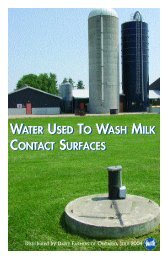Canadian Quality Milk On-Farm Food Safety Program - Centre ...
Canadian Quality Milk On-Farm Food Safety Program - Centre ...
Canadian Quality Milk On-Farm Food Safety Program - Centre ...
Create successful ePaper yourself
Turn your PDF publications into a flip-book with our unique Google optimized e-Paper software.
<strong>Canadian</strong> <strong>Quality</strong> <strong>Milk</strong><br />
instructions.<br />
Consider purchasing a copy of The Compendium of Veterinary Products, which<br />
contains label and insert information for all veterinary drugs and biologics registered<br />
for use in Canada.<br />
4.2.2 Storing and Handling Multiple-Dose Vials of Livestock<br />
Medicines<br />
Even if there are no special instructions, it is essential to prevent the product from<br />
becoming contaminated during use. Whenever multi-dose vials are used, take<br />
precautions to reduce the chances of the vial becoming contaminated during use.<br />
Do not store the bottle with a needle in the rubber stopper.<br />
Use sterile needles to fill syringes from the vial.<br />
Store bottles where the top will not become contaminated.<br />
Swab the top of the bottle with alcohol before use, except when mixing or<br />
withdrawing from bottle of live vaccines.<br />
Finish the bottle within a reasonable time after opening it. Some livestock medicines<br />
that are prepared for use by adding a solution such as sterile water to a dry powder<br />
must be used up within a time that is specified on the label.<br />
If recommended on the label, refrigerate the bottle after opening.<br />
Dispose of products properly.<br />
4.3 TREATMENT CHOICE<br />
Choosing the correct drug, injection site, and dosage to treat a particular disease is<br />
important for effective drug usage and health management. Proper and prudent use of<br />
drugs will ensure that producers treat animals correctly, and do not contribute to<br />
antimicrobial resistance. Treatment decisions should be made in conjunction with a<br />
veterinarian.<br />
4.3.1 General Use of Livestock Medicines and Chemicals<br />
Some of the Best Management Practices for correctly choosing treatments follow:<br />
Read and follow label directions to determine proper dosage and ensure livestock<br />
medicines are administered properly. Some products must be administered in one<br />
particular site or by one particular method.<br />
Use products approved in Canada for use in dairy cattle, or obtain a veterinary<br />
prescription to use veterinary drugs on dairy cattle that are not approved in Canada<br />
or are only approved for use in beef cattle or in other species, or use products listed<br />
in Section 5 of the Permitted Substances Lists for Livestock Production<br />
(CAN/CGSB-32.311-2006) according to the specifications indicated (e.g. hydrogen<br />
peroxide: only food grade quality, can be used for external use as a disinfectant and<br />
it can be added to livestock drinking water as a disinfectant). Any product on the<br />
Permitted Substances Lists used in a manner that is not described on the Permitted<br />
June 2010 4—15
















